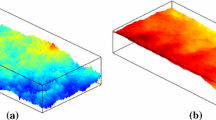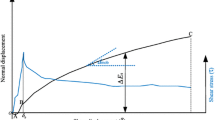Abstract
The friction factor is an important dimensionless parameter for fluid flow through rock fractures that relates pressure head loss to average flow velocity; it can be affected by both fracture geometry and flow regime. In this study, a theoretical formula form of the friction factor containing both viscous and inertial terms is formulated by incorporating the Forchheimer equation, and a new friction factor model is proposed based on a recent phenomenological relation for the Forchheimer coefficient. The viscous term in the proposed formula is inversely proportional to Reynolds number and represents the limiting case in Darcy flow regime when the inertial effects diminish, whereas the inertial term is a power function of the relative roughness and represents a limiting case in fully turbulent flow regime when the fracture roughness plays a dominant role. The proposed model is compared with existing friction factor models for fractures through parametric sensitivity analyses and using experimental data on granite fractures, showing that the proposed model has not only clearer physical significance, but also better predictive performance. By accepting proper percentages of nonlinear pressure drop to quantify the onset of Forchheimer flow and fully turbulent flow, a Moody-type diagram with explicitly defined flow regimes is created for rock fractures of varying roughness, indicating that rougher fractures have a large friction factor and are more prone to the Forchheimer flow and fully turbulent flow. These findings may prove useful in better understanding of the flow behaviors in rock fractures and improving the numerical modeling of non-Darcy flow in fractured aquifers.










Similar content being viewed by others
Abbreviations
- f :
-
Friction factor
- Re:
-
Reynolds number
- ρ :
-
Fluid density
- Q :
-
Volumetric flow rate
- μ :
-
Fluid viscosity
- w :
-
Fracture width
- ξ :
-
Mean peak asperity height
- e h :
-
Hydraulic aperture
- ∇P :
-
Pressure gradient (drop)
- k :
-
Intrinsic permeability of fracture
- A h :
-
Cross-sectional area
- β :
-
Non-Darcy coefficient or inertial resistance
- A, B :
-
Forchheimer coefficients describing pressure losses due to viscous and inertial dissipation mechanisms, respectively
- a D, b D, a, b :
-
Dimensionless coefficients
- D h :
-
Hydraulic diameter
- L :
-
Fracture length
- v :
-
Average velocity
- σ 3 :
-
Confining stress
- T 0, T a :
-
Intrinsic and apparent transmissivity of fracture
- β c :
-
Nonlinear deviation factor
- α :
-
Non-Darcy effect factor
- NOF:
-
Normalized objective function
- γ :
-
Slope of the regression line in the plot of theoretical versus experimental values of friction factor
- RMSE:
-
Root mean square error between the theoretical and experimental values of friction factor
- X :
-
Overall mean of the experimental values of friction factor
References
Arbhabhirama A, Dinoy AA (1973) Friction factor and Reynolds number in porous media flow. J Hydraul Div ASCE 99:901–911
Cammarata G, Fidelibus C, Cravero M, Barla G (2007) The hydro-mechanically coupled response of rock fractures. Rock Mech Rock Eng 40(1):41–61
Chen Z, Qian JZ, Luo SH, Zhan HB (2009) Experimental study of friction factor for groundwater flow in a single rough fracture. J Hydrodyn Ser B 21(6):820–825
Chen Y, Hu S, Wei K, Hu R, Zhou C, Jing L (2014) Experimental characterization and micromechanical modeling of damage-induced permeability variation in Beishan granite. Int J Rock Mech Min Sci 71:64–76
Chen YF, Hu SH, Hu R, Zhou CB (2015a) Estimating hydraulic conductivity of fractured rocks from high pressure packer tests with an Izbash’s law-based empirical model. Water Resour Res 51:2096–2118
Chen YF, Zhou JQ, Hu SH, Hu R, Zhou CB (2015b) Evaluation of Forchheimer equation coefficients for non-Darcy flow in deformable rough-walled fractures. J Hydrol 529:993–1006
Cherubini C, Giasi CI, Pastore N (2012) Bench scale laboratory tests to analyze non-linear flow in fractured media. Hydrol Earth Syst Sci 9(4):5575–5609
Crandall D, Ahmadi G, Smith DH (2010) Computational modeling of fluid flow through a fracture in permeable rock. Transp Porous Med 84(2):493–510
Forchheimer P (1901) Wasserbewegung durch boden. Z Ver Deutsch Ing 45:1782–1788
Fourar M, Bories S, Lenormand R, Persoff P (1993) Two-phase flow in smooth and rough fractures: measurement and correlation by porous-medium and pipe flow models. Water Resour Res 29(11):3699–3708
Javadi M, Sharifzadeh M, Shahriar K, Mitani Y (2014) Critical Reynolds number for nonlinear flow through rough-walled fractures: the role of shear processes. Water Resour Res 50(2):1789–1804
Kohl T, Evans KF, Hopkirk RJ, Jung R, Rybach L (1997) Observation and simulation of non-Darcian flow transients in fractured rock. Water Resour Res 33(3):407–418
Konzuk JS, Kueper BH (2004) Evaluation of cubic law based models describing single-phase flow through a rough-walled fracture. Water Resour Res 40(2):W02402
Li Y, Chen YF, Zhou CB (2014) Hydraulic properties of partially saturated rock fractures subjected to mechanical loading. Eng Geol 179:24–31
Lomize GM (1951) Filtratsiya v treshchinovatykh porodakh. Gosenergoizdat, Moscow
Louis C (1969) A study of groundwater flow in jointed rock and its influence on the stability of rock masses. Imperial College of Science and Technology, London
Ma D, Miao XX, Chen ZQ, Mao XB (2013) Experimental investigation of seepage properties of fractured rocks under different confining pressures. Rock Mech Rock Eng 46(5):1135–1144
Masciopinto C (1999) Particles’ transport in a single fracture under variable flow regimes. Adv Eng Softw 30(5):327–337
Masciopinto C, La Mantia R, Chrysikopoulos CV (2008) Fate and transport of pathogens in a fractured aquifer in the Salento area, Italy. Water Resour Res 44(1):W01404
McDermott CI and Kolditz O (2004) Hydraulic-geomechanical effective stress model: determination of discrete fracture network parameters from a pump test and application to geothermal reservoir modelling. In: Proceedings of 29th workshop on geothermal reservoir engineering, Stanford University, Stanford, SGP-TR-175
Moody LF (1944) Friction factors for pipe flow. Trans Asme 66(8):671–684
Moutsopoulos KN (2009) Exact and approximate analytical solutions for unsteady fully developed turbulent flow in porous media and fractures for time dependent boundary conditions. J Hydrol 369(1):78–89
Nazridoust K, Ahmadi G, Smith DH (2006) A new friction factor correlation for laminar, single-phase flows through rock fractures. J Hydrol 329(1–2):315–328
Nikuradse J (1933) Strömungsgesetze in rauhen Rohren. VDI Forschumgsheft 361, Verein Deutscher Ingenieure. (in German)
Nowamooz A, Radilla G, Fourar M (2009) Non-Darcian two-phase flow in a transparent replica of a rough-walled rock fracture. Water Resour Res 45(7):W07406
Pyrak-Nolte LJ, Myer LR, Cook NGW, Witherspoon PA (1987) Hydraulic and mechanical properties of natural fractures in low permeability rock, In: Proceedings of the Sixth International Congress on Rock Mechanics, pp 225–231
Qian J, Zhan H, Zhao W, Sun F (2005) Experimental study of turbulent unconfined groundwater flow in a single fracture. J Hydrol 311(1):134–142
Qian J, Chen Z, Zhan H, Guan H (2011) Experimental study of the effect of roughness and Reynolds number on fluid flow in rough-walled single fractures: a check of local cubic law. Hydrol Process 25(4):614–622
Ranjith PG, Darlington W (2007) Nonlinear single-phase flow in real rock joints. Water Resour Res 43(9):W09502
Schrauf TW, Evans DD (1986) Laboratory studies of gas flow through a single natural fracture. Water Resour Res 22(7):1038–1050
Sidiropoulou MG, Moutsopoulos KN, Tsihrintzis VA (2007) Determination of Forchheimer equation coefficients a and b. Hydrol Process 21(4):534–554
Singh KK, Singh DN, Ranjith PG (2015) Laboratory simulation of flow through single fractured granite. Rock Mech Rock Eng 48(3):987–1000
Skjetne E, Hansen A, Gudmundsson JS (1999) High-velocity flow in a rough fracture. J Fluid Mech 383:1–28
Tzelepis V, Moutsopoulos KN, Papaspyros JN, Tsihrintzis VA (2015) Experimental investigation of flow behavior in smooth and rough artificial fractures. J Hydrol 521:108–118
Ulusay R, Hudson JA (2007) The complete ISRM suggested methods for rock characterisation, testing and monitoring: 1974–2006. Compilation arranged by the ISRM Turkish National Group, Ankara, Turkey
Wang L, Cardenas MB, Slottke DT, Ketcham RA, Sharp JM (2015) Modification of the Local Cubic Law of fracture flow for weak inertia, tortuosity, and roughness. Water Resour Res 51(4):2064–2080
Whitaker S (1996) The Forchheimer equation: a theoretical development. Transp Porous Media 25(1):27–61
White FM (2003) Fluid mechanics. McGraw-Hill, Boston
Zhang Z, Nemcik J (2013a) Friction factor of water flow through rough rock fractures. Rock Mech Rock Eng 46(5):1125–1134
Zhang Z, Nemcik J (2013b) Fluid flow regimes and nonlinear flow characteristics in deformable rock fractures. J Hydrol 477:139–151
Zhang Z, Nemcik J, Qiao Q, Geng X (2015) A model for water flow through rock fractures based on friction factor. Rock Mech Rock Eng 48(2):559–571
Zhou JQ, Hu SH, Fang S, Chen YF, Zhou CB (2015) Nonlinear flow behaviors at low Reynolds number through rough-walled fractures subjected to normal compressive loading. Int J Rock Mech Min Sci 80:202–218
Zimmerman RW, Bodvarsson GS (1996) Hydraulic conductivity of rock fractures. Transp Porous Media 23(1):1–30
Zimmerman RW, Al-Yaarubi A, Pain CC, Grattoni CA (2004) Nonlinear regimes of fluid flow in rock fractures. Int J Rock Mech Min Sci 41:1A27
Zou L, Tarasov BG, Dyskin AV, Adhikary DP, Pasternak E, Xu W (2013) Physical modelling of stress-dependent permeability in fractured rocks. Rock Mech Rock Eng 46(1):67–81
Acknowledgments
The authors Gratefully thank the anonymous reviewers for their kind efforts and constructive comments in improving this study. Financial supports from the National Natural Science Foundation of China (No. 51579188), the National Basic Research Program of China (No. 2011CB013503), and the China Postdoctoral Science Foundation (No. 2015M580672) are Gratefully acknowledged.
Author information
Authors and Affiliations
Corresponding author
Rights and permissions
About this article
Cite this article
Zhou, JQ., Hu, SH., Chen, YF. et al. The Friction Factor in the Forchheimer Equation for Rock Fractures. Rock Mech Rock Eng 49, 3055–3068 (2016). https://doi.org/10.1007/s00603-016-0960-x
Received:
Accepted:
Published:
Issue Date:
DOI: https://doi.org/10.1007/s00603-016-0960-x




